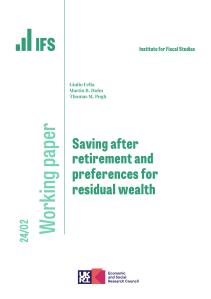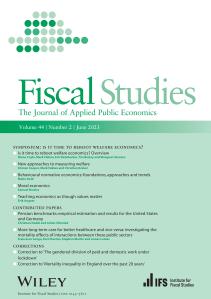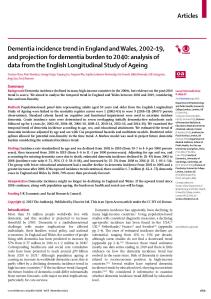A major new report, published today as part of the Pensions Review, led by the Institute for Fiscal Studies in partnership with the abrdn Financial Fairness Trust, suggests a new way forward for the state pension system, designed to provide a basis for financial security in retirement and ensure the state pension has a sustainable long-term future.
As has happened with the National Living Wage, government should state what it believes to be an appropriate level for the new state pension relative to average earnings. It currently stands at 30% of median full-time earnings, which is its highest share since at least 1968, though it remains less generous than state pensions provided in many other advanced economies that have much more limited provision of private pensions. Having set a target, the government should then legislate a pathway to meet it with a specific timetable. In choosing the level of the new state pension, the government has to consider the trade-off between a higher income for pensioners and the cost to the public finances.
The current state pension has many strengths, not least its simplicity. But research by the Pensions Review indicates several problems. There is no sense of what level the pension will reach or when – the ‘triple lock’ provides neither future pensioners nor government with any certainty regarding the level of the state pension. Many younger people have little confidence in the continued existence of the pension. And decisions over increasing state pension age are uncertain.
For the long-run direction for the state pension, the Pensions Review suggests a new ‘four-point pension guarantee’ to provide greater certainty and confidence over what people can expect to receive from the state pension. These four points are:
1. Once the state pension has reached its target level, increases in the state pension will in the long run keep pace with growth in average earnings, which ensures that pensioners benefit when living standards rise.
2. Both before and after the target level is reached, the state pension will continue to increase at least in line with inflation every year.
3. The state pension will not be means-tested.
4. The state pension age will only rise as longevity at older ages increases, and never by the full amount of that longevity increase. To increase confidence and understanding, the government will write to people around their 50th birthday stating what their state pension age is expected to be. Their state pension age would then be fully guaranteed 10 years before they reach it.
These suggestions are carefully designed to build on the strengths of the current state pension system and to address some of the key challenges identified in the Pensions Review report.
Some of these key challenges are:
• The ageing population will add considerable pressure on public finances in coming decades. Current projections show that by 2050 the number of people above the state pension age will rise by 25% compared with today – this will put upwards pressure on both state pension spending and, to an even greater extent, public spending on health and social care.
• While there is naturally a debate about the right level of the state pension, the ‘triple lock’ indexation policy (which increases the state pension each year by the highest of inflation, average earnings growth and 2.5%) ratchets up the value of, and spending on, the state pension over time in a way that creates uncertainty around its level relative to average earnings, and for the public finances.
• If the government wants to rein in state pension spending then relying only on raising the state pension age would hit those with lower life expectancy, such as poorer people, harder. This is because the same increase in the state pension age has a larger proportional impact on the total state pension income received between state pension age and death for people who die at younger ages than for people who live longer. In contrast, relative to earnings indexation, the triple lock is of more benefit to those who have higher life expectancy, such as richer people, because they are more likely to be receiving a state pension into their 90s.
• Despite its new-found simplicity, there is a mixture of confusion and pessimism about the state pension. Although the state pension has increased at least as fast as inflation every year since 1975, 38% of people think that in the next 10 years it will not keep up with inflation. Pessimism is also widespread; a third of people do not think the state pension will exist in 30 years’ time.
Heidi Karjalainen, a Research Economist at IFS and author of the report, said:
‘A commitment by the government to a set level of the new state pension relative to average earnings would ensure that pensioners continue to benefit from higher state pensions as living standards rise. Under our suggested guarantee, they would also be protected from falls in their purchasing power when inflation is high or earnings growth is very weak. In choosing a target, the government would have to balance carefully the benefits of a higher state pension income, and the cost to the public finances of providing the pension.’
Carl Emmerson, Deputy Director at IFS and another author of the report, said:
‘The current state pension system, and especially the new state pension, has much to commend it, but a number of challenges remain. In particular, the ageing population leads to uncertainty around the long-term sustainability of the system. A new way forward is needed to ensure that people can have confidence and certainty over the state pension as a future source of income to help avoid old-age poverty and provide a solid bedrock on top of which they can build private pension saving.’
Mubin Haq, CEO of abrdn Financial Fairness Trust, said:
‘The state pension is a fundamental part of our social contract with government. We all want to feel confident it is secure. However, without assurances about its future, government risks undermining the public’s trust in its sustainability. The government made a bold decision to link the National Living Wage to earnings which has cemented support for this policy. A similar measure is now needed for the state pension to deliver the financial security and living standards we all need in retirement.’











